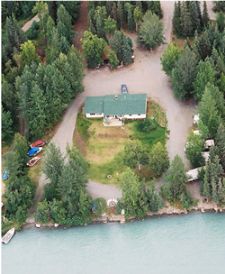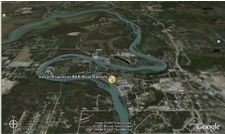The steelhead trout (Oncorhynchus mykiss *) is a rainbow trout that has spent a part of its life in the sea. There are no major physical differences between rainbow and steelhead trout; however, the nature of their differing lifestyles has resulted in subtle differences in color, shape, and general appearance.
General description: Like all trout, the steelhead are positively separated from the various salmon species by having eight to twelve rays in the anal fin. The rainbow trout/steelhead group are then separated from the brook trout, lake trout, and Dolly Varden by the complete absence of teeth at the base of the tongue. Generally speaking, steelhead are more slender and streamlined than resident rainbow. Like rainbow, the coloration on the back is basically blue-green shading to olive with black, regularly spaced spots. The black spots also cover both lobes of the tail. The black coloration fades over the lateral line to a silver white coloration blending more to white on the stomach. Steelhead from the ocean are much more silver than the resident rainbow. On steelhead the typical colors and spots of the trout appear to be coming from beneath a dominant silvery sheen. The silvery sheen gradually fades in fresh water, and steelhead become difficult to differentiate from resident rainbow trout as the spawning period approaches. Steelhead and rainbow lack the red slash on the underjaw characteristic of cutthroat trout, but do have white leading edges on the anal, pectoral, and pelvic fins. Spawning steelhead and rainbow develop a distinct pink to red strip-like coloration that blends along the side, both above and below the lateral line. On steelhead, the rainbow trout coloration gradually fades following spawning to the more characteristic silvery color that the fish display during their ocean journey. The distinct and beautiful coloration of steelhead during the freshwater spawning period is apparently important in regard to the mating and reproductive process. The silvery sheen and streamlined shape of ocean-bright steelhead is essential to survival in the ocean environment.
Juvenile steelhead trout are identical to rainbow trout until the period prior to their ocean migrations. Young trout and stunted adults have eight to thirteen parr marks on their sides. There are five to ten parr marks between the head and dorsal fin. Prior to migrating to the sea, juvenile steelhead become very silvery and resemble miniature adults. They are called smolt during this life phase.
Distribution: Steelhead are found in the coastal streams of Alaska from Dixon Entrance northward and west around the Gulf of Alaska down to the Cold Bay area on the Alaska Peninsula. There are no documented populations of steelhead on the Alaska mainland west of the Susitna River and north of the Chignik River system. This area is generally known as Bristol Bay and contains excellent resident rainbow trout populations but no steelhead.
We have little information on the ocean migration of Alaska steelhead; however, large numbers are intercepted in high seas fisheries, and undoubtedly many of these fish are of Alaska origin. Steelhead migrate to areas west of the Aleutian Islands and are routinely caught in net fisheries off the coast of Japan.
Life history: When compared to the mundane habits of resident trout, steelhead lead a very complicated and dangerous life. Each spring thousands of 6-inch steelhead smolt leave the streams to begin their ocean journeys. For every 100 smolt that reach the sea, only five to ten will return as a first-spawning adult. Within a one-, two-, or sometimes three-year period, Alaska steelhead will have moved hundreds of miles from the parent stream. Some populations return to the home stream as early in the year as July and are known as “summer steelhead.” Summer steelhead are relatively rare in Alaska and found in only a few select Southeast Alaska streams. “Fall” run steelhead are much more common, particularly in the systems north of Frederick Sound. These fish enter the freshwater systems as adults in August, September, October, and on into the winter. Anchor, Naha, Karluk, and Situk rivers have good runs of fall run steelhead. Many of the Southeast Alaska systems have spring run steelhead. These fish end their ocean journeys in mid-April, May, and June. In many rivers, bright, shiny spring run fish can be observed mixed with rainbow-marked spawners that have spent the entire winter waiting for the spring spawning period.
Spawning commences about mid-April and usually occurs throughout May and early June. A male may spawn with several females, and more males than females die during the spawning period.
Unlike salmon, steelhead commonly spawn more than once, and fish over 28 inches are almost always repeat spawners. The ragged and spent spawners move slowly downstream to the sea, and the spawning, rainbow colors of spring return to a bright silvery hue. Lost fats are restored and adults again visit the feeding regions of their first ocean migration. On rare occasions a fish will return to the stream within a few months, but most repeat spawners spend at least one winter in the sea between spawning migrations.
While adult spawning wounds are healing and growth resumes, the eggs which were deposited deep in the gravel during the spring quickly develop into alevins or “sac-fry.” These tiny fish gradually absorb the yolk sac and work their way to the surface. By mid summer fry emerge from the gravel, minus the yolk sac, and seek refuge along stream margins and in protected areas. Tremendous numbers of eggs and fry are killed or washed from the stream each year, but by fall 2- to 3-inch steelhead populate habitat that, hopefully, will carry them through the first winter. Generally, the juvenile steelhead will remain in the parent stream for about three years before outmigrating to salt water.
If all steelhead left the stream at the same age, returned after the same length of time in the ocean, and died after spawning, the adults in a given stream would be of similar age. They don’t. Add to this the complications of summer run, spring run, and fall run fish spawning at the same time and in the same stream, and you have a rather complicated situation. Perhaps nature has conspired to make steelhead life history complicated so that a harsh flood, winter, or drought does not destroy all of a given population.
Sport fishing: Adult steelhead like fast, deep, running water. Fish the deep holes in the stream. Fish the fast, white water areas and behind rocks and log jams. Quite often large holes form in front of log jams and these areas should not be overlooked.
Steelhead like colorful flies such as the Russian River coho, hair skyhomish, skyhomish sunrise, red rascal, and polar shrimp. Confusing? Try egg imitations. A single hook with a tuft or strand of orange yarn is often just the ticket for steelhead. Hardware works too, and small spoons to large spinners will catch steelhead.
Catch-and-release: Anglers are encouraged to practice catch-and-release when fishing for steelhead. When rigging for steelhead, consider removing the barbs from your terminal gear. Steelhead are usually hooked in the outer mouth parts. This means that they will live to spawn or bite again if gently released. Removing the barb from your hook will allow you to release the fish without even taking it from the water. While it is legal to take steelhead, these stocks are limited and easily overexploited. By practicing catch-and-release and limiting harvest of steelhead, fishers can help maintain this species.
*Use a single hook, artificial lure or fly.
*Land fish quickly.
*Handle fish with wet hands, no net.
*Keep fish in water, handling gently.
*Keep hands and fingers away from gills.
*Carefully remove hook or cut line.
*Revive fish by moving it gently back and forth in the water before releasing it.
Text: Frank Van Hulle
Illustration: Ashley Dean
* The scientific name for steelhead has been revised. This page shows the current and correct scientific name. (In 1988, The American Fisheries Society published a symposium proceedings (cited below) and in that document they included a paper by Robert L. Kendall, the Managing Editor of the American Fisheries Society on Nomenclatural Changes. For additional information see the following: Gresswell, R. E. 1988. Status and management of interior stocks of cutthroat trout. American Fisheries Society Symposium 4.)






